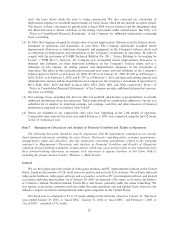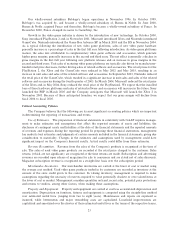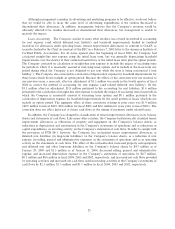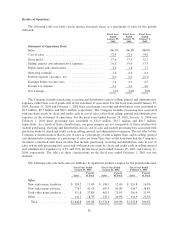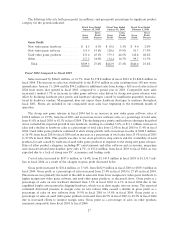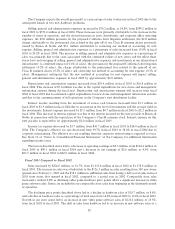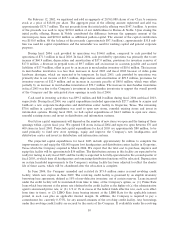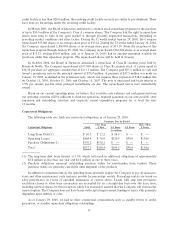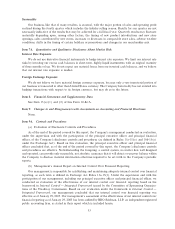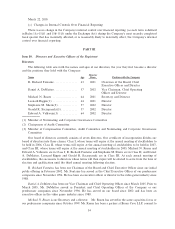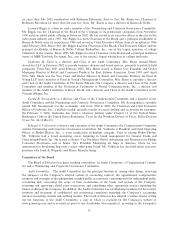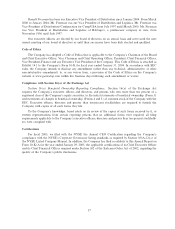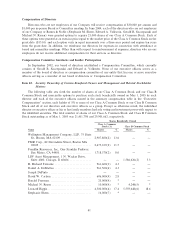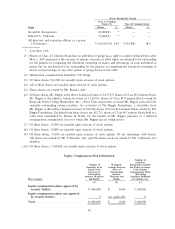GameStop 2004 Annual Report Download - page 39
Download and view the complete annual report
Please find page 39 of the 2004 GameStop annual report below. You can navigate through the pages in the report by either clicking on the pages listed below, or by using the keyword search tool below to find specific information within the annual report.OÅ-Balance Sheet Arrangements
As of January 29, 2005, the Company had no oÅ-balance sheet arrangements as deÑned in Item 303 of
Regulation S-K.
Impact of InÖation
We do not believe that inÖation has had a material eÅect on our net sales or results of operations.
Certain Relationships and Related Transactions
The Company operates departments within ten bookstores operated by Barnes & Noble. The Company
pays a license fee to Barnes & Noble in amounts equal to 7.0% of the gross sales of such departments.
Management deems the license fee to be reasonable and based upon terms equivalent to those that would
prevail in an arm's length transaction. During the 52 weeks ended January 29, 2005, January 31, 2004 and
February 1, 2003, these charges amounted to $0.9 million, $1.0 million and $1.1 million, respectively.
The Company participates in Barnes & Noble's worker's compensation, property and general liability
insurance programs. The costs incurred by Barnes & Noble under these programs are allocated to the
Company based upon the Company's total payroll expense, property and equipment, and insurance claim
history. Management deems the allocation methodology to be reasonable. During the 52 weeks ended
January 29, 2005, January 31, 2004 and February 1, 2003, these allocated charges amounted to $2.7 million,
$2.4 million and $1.7 million, respectively. The Company's participation in Barnes & Noble's insurance
programs will expire in Ñscal 2005 and the Company will secure new insurance coverage.
In July 2003, the Company purchased an airplane from a company controlled by a member of the Board
of Directors. The purchase price was $9.5 million and was negotiated through an independent third party
following an independent appraisal.
In October 2004, the Board of Directors authorized a repurchase of Class B common stock held by
Barnes & Noble. The Company repurchased 6,107,000 shares of Class B common stock at a price equal to
$18.26 per share for aggregate consideration of $111.5 million. The repurchase price per share was determined
by using a discount of 3.5% on the last reported trade of the Company's Class A common stock on the New
York Stock Exchange prior to the time of the transaction. The Company paid $37.5 million in cash and issued
a promissory note in the principal amount of $74.0 million, which is payable in installments over the next three
years and bears interest at 5.5% per annum, payable when principal installments are due. The Company made
a principal payment of $37.5 million on the promissory note in January 2005. Interest expense on the
promissory note for the 52 weeks ended January 29, 2005 totaled $1.3 million.
Recent Accounting Pronouncements
In December 2004, the FASB issued Statement of Financial Accounting Standard No. 123 (Revised
2004), Share-Based Payment, (""FAS 123(R)''). This Statement requires companies to expense the
estimated fair value of stock options and similar equity instruments issued to employees. Currently, companies
are required to calculate the estimated fair value of these share-based payments and can elect to either include
the estimated cost in earnings or disclose the pro forma eÅect in the footnotes to their Ñnancial statements. We
have chosen to disclose the pro forma eÅect. The fair value concepts were not changed signiÑcantly in
FAS 123(R), however, in adopting this Standard, companies must choose among alternative valuation models
and amortization assumptions. The valuation model and amortization assumption we have used continue to be
available, but we have not yet completed our assessment of the alternatives. FAS 123(R) will be eÅective for
the Company beginning with the third quarter of 2005. Transition options allow companies to choose whether
to adopt prospectively, restate results to the beginning of the year, or to restate prior periods with the amounts
on a basis consistent with pro forma amounts that have been included in their footnotes. We have not yet
concluded which transition option we will select. For the pro forma eÅect of a full year application, using our
existing valuation and amortization assumptions, see Note 1 of Notes to Consolidated Financial Statements
included in Item 15 of this Report on Form 10-K/A.
32


